Are You Concerned About Using Pre-Hire Assessments?
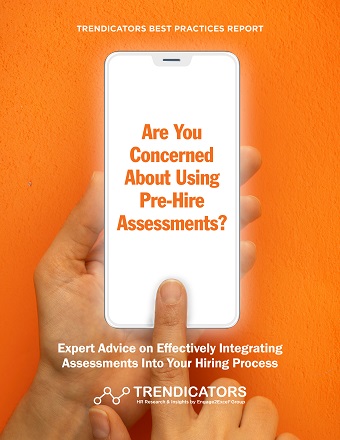
Pre-Hire Assessment
A pre-hire assessment is a test or questionnaire that candidates complete as part of the job application process. The use of a valid and expert assessment is an effective way to determine which applicants are the most qualified for a specific job based on their strengths and preferences. Employers typically use the results to determine how well each candidate’s strengths and preferences match the job requirements.
This report provides practical guidance on issues and concerns regarding the use of standardized, self-completed assessments, which include cognitive ability tests, job knowledge tests, personality inventories, biodata inventories and situational judgment tests. According to Emergen Research, the global assessment services market is projected to reach USD 11.47 Billion by 2027.
Introduction
Over the past four years, the Trendicators research division of the Engage2Excel Group has produced more than 50 eBooks and survey reports on employee engagement, recognition and rewards, performance management, recruiting, onboarding and diversity and inclusion.
This report, Are You Concerned About Using Pre-Hire Assessments?, marks a new direction for our publications. In January, we convened a Trendicators Advisory Board to help shape the topics and content of our reports. Each quarter, board members will pick a topic, contribute their insights and experiences on that topic via roundtable discussion and participate in editorial review prior to publication.
The content for this report is the result of a roundtable discussion held on February 7, 2022, with advisory board members and Engage2Excel subject matter experts. James Longabaugh, Ph.D., Director of Consulting Services for Workforce Science Associates, opened the discussion with a presentation on the state of the assessment industry. Then, each of our advisory board members shared their experiences with using pre-hire assessments, along with concerns they have heard from peers about using pre-hire assessments in today’s challenging hiring environment.
This eBook provides expert advice for effectively integrating pre-hire assessments into hiring processes to improve hiring effectiveness.
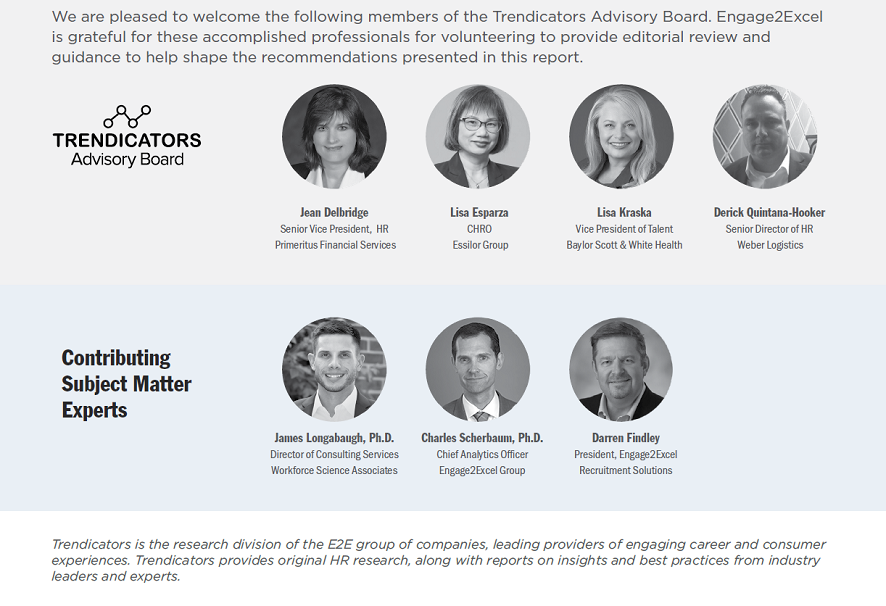
Download
 hbspt.cta.load(123973, '8e481f35-49da-4774-ba4e-a49fc8f74495', {"useNewLoader":"true","region":"na1"});
hbspt.cta.load(123973, '8e481f35-49da-4774-ba4e-a49fc8f74495', {"useNewLoader":"true","region":"na1"});
INTEGRATING ASSESSMENTS INTO YOUR HIRING PROCESS
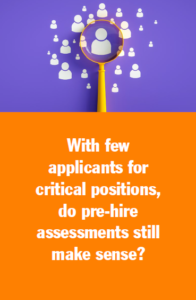 There is a common misperception that when organizations are having difficulty filling open positions, pre-hire assessments should be abandoned to streamline the process of filling seats. However, with fewer candidates to choose from, the right prehire assessments offer an objective perspective to help identify the best-qualified candidates and reduce hiring inefficiencies.
There is a common misperception that when organizations are having difficulty filling open positions, pre-hire assessments should be abandoned to streamline the process of filling seats. However, with fewer candidates to choose from, the right prehire assessments offer an objective perspective to help identify the best-qualified candidates and reduce hiring inefficiencies.
Economic Considerations: The key question to consider for any given job role is: What is the cost of hiring and then having to replace a bad hire? People who lack the appropriate knowledge, skills and abilities (KSAs) will likely be less engaged, be poor performers and have high turnover rates. This can contribute to a toxic work environment. The cost of replacing an employee and the business impact of an unfilled position is heightened in a tight labor market. These are important reasons to consider using pre-hire assessments to help make the smartest possible decisions for each new hire.
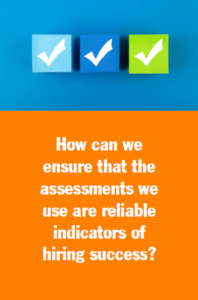
It is the responsibility of your assessment provider to demonstrate the reliability and validity of an assessment for a given job role. Ask the vendor for evidence that an assessment or combination of assessments is job-related and produces reliable scores. Also, ask about group difference (male vs. female) on the assessment and the potential for adverse impact.
Reliability & Predictability: Any credible off-the-shelf assessment will have evidence to support its reliability and job-relatedness (i.e., validity). Reliability refers to consistency of assessment scores over time, over different versions, or over similar items. Validity reflects “the degree to which evidence and theory support the interpretations of test scores for proposed uses of tests” (SIOP, 2018). There are many different professionally accepted strategies for establishing validity and reliability. The key is to work with your vendor to determine if the existing validity evidence applies to your situation and will meet legal requirements. If not, one will need to work with the vendor to establish the validity evidence of the assessment in your organization.
Download
 hbspt.cta.load(123973, '8e481f35-49da-4774-ba4e-a49fc8f74495', {"useNewLoader":"true","region":"na1"});
hbspt.cta.load(123973, '8e481f35-49da-4774-ba4e-a49fc8f74495', {"useNewLoader":"true","region":"na1"});
INTEGRATING ASSESSMENTS INTO YOUR HIRING PROCESS
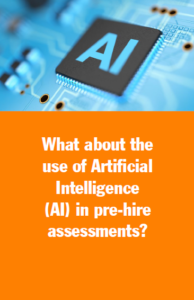 The use of AI in applicant screening is a controversial topic, and for good reason. Consider that AI can analyze millions of data points. Take, for example, an AI algorithm that analyzes information within an individual’s LinkedIn profile, social media posts, resume and other sources of publicly available data. There could be unknown biases built into that algorithm. In 2018, Reuters reported that Amazon shelved an internally developed AI-based assessment when they discovered it was biased against women.
The use of AI in applicant screening is a controversial topic, and for good reason. Consider that AI can analyze millions of data points. Take, for example, an AI algorithm that analyzes information within an individual’s LinkedIn profile, social media posts, resume and other sources of publicly available data. There could be unknown biases built into that algorithm. In 2018, Reuters reported that Amazon shelved an internally developed AI-based assessment when they discovered it was biased against women.
AI for Volume Hires: When AI is applied to scientifically designed and validated pre-hire assessments and processes, it can lessen adverse impacts on protected classes and mitigate human decision-making biases in the candidate selection process. For high-volume recruiting, technologies such as AI, machine learning and workflow automation can result in better candidate experiences, reduced time-to-hire and better hiring outcomes. For more information on AI in recruiting, see the resources below.
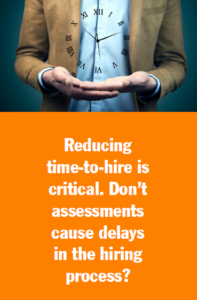
Another common misperception is that pre-hire assessments increase the length of the hiring cycle. However, when appropriately used, assessments create efficiency by enabling hiring managers to focus on candidates who are most likely to succeed. Many organizations screen out the bottom 20% to 30% of candidates based on test scores. This streamlines the hiring process by eliminating the need to interview and screen less qualified candidates, moving the best-qualified people forward faster. It also creates a more standardized approach to hiring, offering objective data for comparison early in the hiring process.
Assessment Success Stories: A large auto parts retailer saved nearly $1 million in managers’ time by not having them interview the bottom 30% of applicants. Similarly, a U.S. pharmacy chain saved millions of hours in managers’ time with pre-hire assessments while significantly reducing new hire turnover. When used properly, these assessments provide evidence-based insights to counterbalance subjectivity, which occurs when interviewers form opinions based on their thoughts, experiences and opinions.
Download
 hbspt.cta.load(123973, '8e481f35-49da-4774-ba4e-a49fc8f74495', {"useNewLoader":"true","region":"na1"});
hbspt.cta.load(123973, '8e481f35-49da-4774-ba4e-a49fc8f74495', {"useNewLoader":"true","region":"na1"});
INTEGRATING ASSESSMENTS INTO YOUR HIRING PROCESS
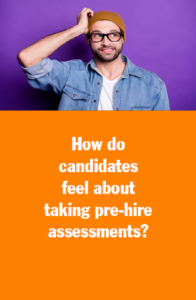 The soon-to-be-released 2022 Trendicators Job Seeker Survey report reveals that 72% of respondents expect to complete between one and three assessments when applying for a job. This percentage has remained relatively constant since we first asked the question in 2019.
The soon-to-be-released 2022 Trendicators Job Seeker Survey report reveals that 72% of respondents expect to complete between one and three assessments when applying for a job. This percentage has remained relatively constant since we first asked the question in 2019.
Assessments are an expected part of the modern candidate experience. An estimated 80% of the Fortune 500 use pre-employment testing because the evidence for a business benefit is overwhelmingly positive. A recent survey of 1,000 talent acquisition professionals showed that those who used pre-hire assessments were 3.7 times more likely to rate their quality of hires as “excellent” than those who did not use pre-hire assessments.*
SOURCE: Hiring During the Great Resignation: What’s Changing and What’s Working? 2021, Wonderlic.

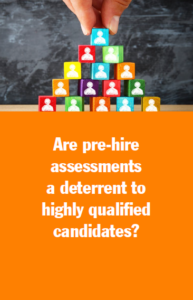 When informed of why and how pre-hire assessments can help them identify job opportunities that are a good fit, qualified candidates want to demonstrate their strengths, skills and abilities. Only 5% of respondents in our 2022 survey said they did not expect to take any assessments.
When informed of why and how pre-hire assessments can help them identify job opportunities that are a good fit, qualified candidates want to demonstrate their strengths, skills and abilities. Only 5% of respondents in our 2022 survey said they did not expect to take any assessments.
Career Mobility and Succession Planning: One vastly underutilized benefit of pre-hire assessments is the value they provide in identifying talent for under-resourced roles and succession planning. When employee assessment data is aggregated and analyzed against other key internal metrics for performance and retention, this data can serve as an inventory of an organization’s intellectual capital. Integrating assessments into career planning portals, for example, enables individuals who feel underutilized to identify open positions that may better match their skills, abilities and career interests. Assessments that measure managerial and leadership abilities can help identify pools of candidates for career development to aid in succession planning.
Download
 hbspt.cta.load(123973, '8e481f35-49da-4774-ba4e-a49fc8f74495', {"useNewLoader":"true","region":"na1"});
hbspt.cta.load(123973, '8e481f35-49da-4774-ba4e-a49fc8f74495', {"useNewLoader":"true","region":"na1"});
INTEGRATING ASSESSMENTS INTO YOUR HIRING PROCESS
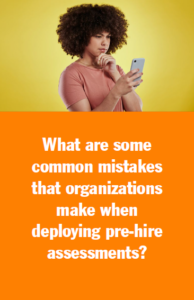 The two most common mistakes employers make are not explaining the hiring process to applicants and not aligning recruiting experiences with the target audience.
The two most common mistakes employers make are not explaining the hiring process to applicants and not aligning recruiting experiences with the target audience.
Persistent Communications: Creating a great candidate experience is vital to attracting the best-qualified individuals. Let candidates know what to expect and when to expect it from the very start, and keep them informed of where they are in the hiring process. Explain what assessments they will be taking, how they relate to the job and how they enable qualified individuals to put their best foot forward.
Audience Alignment: While some assessments only work on desktop or laptop computers, it is a mistake not to offer tests that are optimized for mobile devices, especially for entry-level positions. According to our soon-to-be-released report, 91% of job seekers expect the application process to be mobile friendly.
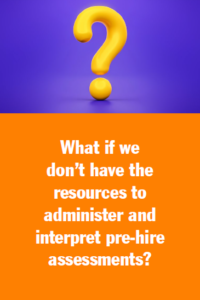 This report provides a concise overview of the challenges and misperceptions that have kept talent leaders from effectively integrating pre-hire assessments into their hiring processes. But many organizations, particularly mid-market companies with limited HR resources, do not use pre-hire assessments because they feel overwhelmed with current recruiting challenges or do not feel they can manage and interpret the assessment results.
This report provides a concise overview of the challenges and misperceptions that have kept talent leaders from effectively integrating pre-hire assessments into their hiring processes. But many organizations, particularly mid-market companies with limited HR resources, do not use pre-hire assessments because they feel overwhelmed with current recruiting challenges or do not feel they can manage and interpret the assessment results.
Getting Expert Assistance: To get started on a program to deploy pre-hire assessments, ask your recruitment partner for help. Many can create such a program as part of a recruitment process outsourcing initiative. In particular, they can help you identify the best job roles to start with, deploy assessments on your behalf and stack rank candidates to help hiring managers identify the best-qualified candidates. For more extensive assistance, consider hiring a consultant to assess your entire selection process—from application to onboarding—to improve hiring effectiveness.
Download
 hbspt.cta.load(123973, '8e481f35-49da-4774-ba4e-a49fc8f74495', {"useNewLoader":"true","region":"na1"});
hbspt.cta.load(123973, '8e481f35-49da-4774-ba4e-a49fc8f74495', {"useNewLoader":"true","region":"na1"});
Resource Links
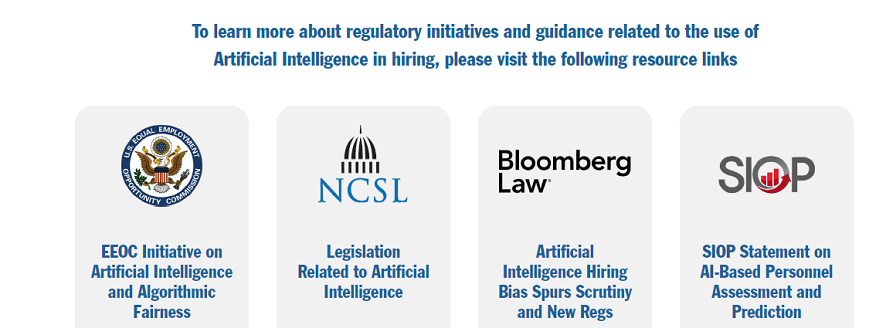
EEOC Launches Initiative on Artificial Intelligence and Algorithmic Fairness
Employment Tests and Selection Procedures
Legislation Related to Artificial Intelligence
Artificial Intelligence Hiring Bias Spurs Scrutiny and New Regs
SIOP Statement on the use of Artificial Intelligence (AI) for Hiring
Expert Content Advisors
James Longabaugh, Ph.D., is the Director of Consulting Services for Workforce Science Associates. He has extensive experience developing pre-employment assessment and selection programs for organizations to hire their share of high-quality talent, implementing assessment and coaching programs to develop the next generation of leaders and leveraging workforce analytics and artificial intelligence to discover meaningful insight to drive change. For more information, visit workforcescience.com
Charles Scherbaum, Ph.D., is a professor of I-O psychology at Baruch College, City University of New York. He is a recognized expert in talent management, employee selection, and assessment. Dr. Scherbaum has published extensively and won 6 awards from the Society for Industrial and Organizational Psychology and the International Personnel Assessment Council for his research on these topics. Dr. Scherbaum consults with private and public organizations on assessment and serves as an expert in employment ligation including for the U.S. Department of Justice and EEOC.
Darren Findley is President of Engage2Excel Recruitment Solutions. During his 30+-year career, he has led global high volume RPO programs with Fortune 100 companies and helped organizations grow from 100’s of employees to hundreds of thousands. He is a believer in and passionate about helping organizations find and keep talent. He works with CHRO’s and senior talent acquisition leaders to move them toward a transformational recruitment maturity model that positions them to compete for the best talent in their markets, utilize technology and adopt best practices to become more efficient on their journey to support their organizational goals.
Download
 hbspt.cta.load(123973, '8e481f35-49da-4774-ba4e-a49fc8f74495', {"useNewLoader":"true","region":"na1"});
hbspt.cta.load(123973, '8e481f35-49da-4774-ba4e-a49fc8f74495', {"useNewLoader":"true","region":"na1"});